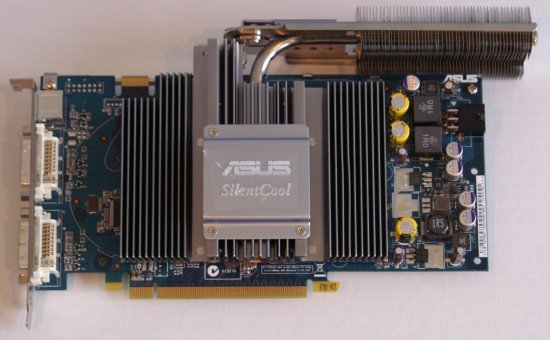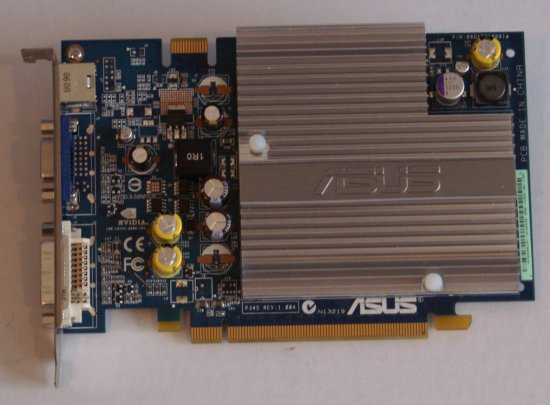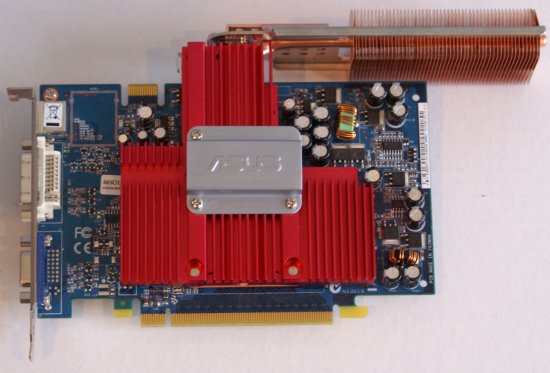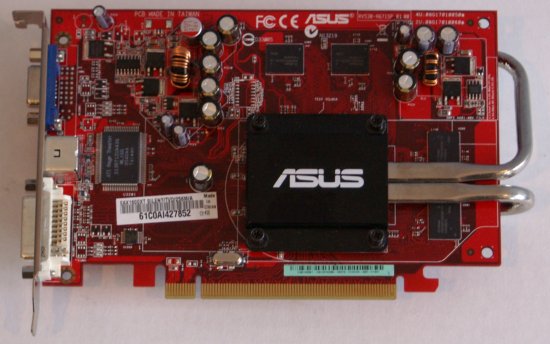ASUS
We start our silent card roundup by looking at some cards by ASUS, a company that has impressed us with its quality in the past. For this roundup, ASUS has submitted four silent NVIDIA cards and a silent ATI card.


First we have the ASUS NVIDIA GeForce EN7800 GT Top Silent, a powerful card considering its silent design. As its name implies, the EN7800GT uses NVIDIA's 7800 GT GPU. This is an interesting card because, aside from its high performance GPU, its heatsink is designed with an arm extending from the side of the card that has the ability to swivel out 90 degrees so that air being pulled from the CPU fan can provide extra cooling. The arm can also remain closed if space is an issue, and the card still works fine. This is also the most powerful silent card we have for this review, and it comes with a slightly higher factory clock than a standard 7800 GT (420MHz/1.24GHz).

Second, we have the ASUS NVIDIA GeForce 7600 GS Silent 512. As the name suggests, this card has 512 MB memory instead of the standard 256 MB and is based on NVIDIA's 7600 GS GPU. However, the memory clock speed is set significantly lower than the standard 256 MB 7600 GS (540MHz vs. the standard 800MHz). This card as well as the 256 MB version have metal heat sinks that cover the front of the card, and curl over the top and down the back about an inch.

The ASUS NVIDIA GeForce 7600 GS Silent is the 256MB version of the above card. It's factory clocked the same as a standard 7600 GS, with a 400MHz core and an 800MHz memory clock speed. Both the 512 MB and 256 MB versions of this card look exactly the same. It is possible that when Windows Vista becomes available, the added memory of the 512MB version will prove useful, but at present there's little reason to recommend having additional RAM at a slower clock speed.

The ASUS EN6600 GT Silencer is very similar in design to the EN7800 GT Top Silent, with a rotating-arm heat sink that extends from the side of the card. The EN6600 GT's heat sink is a bit smaller and lighter than the EN7800 GT, which makes sense given the 6600's smaller size. Also similarly to the EN7800 GT Top Silent, this is the only card of its kind (6600 GT) in this review. On the NVIDIA side, our main focus will be on 7600 and 7300 cards, and for ATI the X1300 and X1600 offerings.

And lastly, we have an ATI offering by ASUS: the Radeon EAX1600 XT Silent. This is our most powerful ATI card for this review, and this particular X1600 XT has an interesting heat sink design. There is a small black heat sink on the face of the card just covering the processor, and two metal heatpipes extend around the end and to the back of the card, which holds a much larger heat sink. We will list the current prices for these as well as the rest of our cards in the "Cards Summary and Prices" section later on.
We start our silent card roundup by looking at some cards by ASUS, a company that has impressed us with its quality in the past. For this roundup, ASUS has submitted four silent NVIDIA cards and a silent ATI card.


First we have the ASUS NVIDIA GeForce EN7800 GT Top Silent, a powerful card considering its silent design. As its name implies, the EN7800GT uses NVIDIA's 7800 GT GPU. This is an interesting card because, aside from its high performance GPU, its heatsink is designed with an arm extending from the side of the card that has the ability to swivel out 90 degrees so that air being pulled from the CPU fan can provide extra cooling. The arm can also remain closed if space is an issue, and the card still works fine. This is also the most powerful silent card we have for this review, and it comes with a slightly higher factory clock than a standard 7800 GT (420MHz/1.24GHz).

Second, we have the ASUS NVIDIA GeForce 7600 GS Silent 512. As the name suggests, this card has 512 MB memory instead of the standard 256 MB and is based on NVIDIA's 7600 GS GPU. However, the memory clock speed is set significantly lower than the standard 256 MB 7600 GS (540MHz vs. the standard 800MHz). This card as well as the 256 MB version have metal heat sinks that cover the front of the card, and curl over the top and down the back about an inch.

The ASUS NVIDIA GeForce 7600 GS Silent is the 256MB version of the above card. It's factory clocked the same as a standard 7600 GS, with a 400MHz core and an 800MHz memory clock speed. Both the 512 MB and 256 MB versions of this card look exactly the same. It is possible that when Windows Vista becomes available, the added memory of the 512MB version will prove useful, but at present there's little reason to recommend having additional RAM at a slower clock speed.

The ASUS EN6600 GT Silencer is very similar in design to the EN7800 GT Top Silent, with a rotating-arm heat sink that extends from the side of the card. The EN6600 GT's heat sink is a bit smaller and lighter than the EN7800 GT, which makes sense given the 6600's smaller size. Also similarly to the EN7800 GT Top Silent, this is the only card of its kind (6600 GT) in this review. On the NVIDIA side, our main focus will be on 7600 and 7300 cards, and for ATI the X1300 and X1600 offerings.

And lastly, we have an ATI offering by ASUS: the Radeon EAX1600 XT Silent. This is our most powerful ATI card for this review, and this particular X1600 XT has an interesting heat sink design. There is a small black heat sink on the face of the card just covering the processor, and two metal heatpipes extend around the end and to the back of the card, which holds a much larger heat sink. We will list the current prices for these as well as the rest of our cards in the "Cards Summary and Prices" section later on.










49 Comments
View All Comments
imaheadcase - Thursday, August 31, 2006 - link
I guess to each his own, i play bf2 on a 19inch CRT monitor at 1024x768. But even if i had a better card i would still prefer lower rez.DerekWilson - Thursday, August 31, 2006 - link
it's an issue of how games work on the inside ...all the objects, shapes, characters, and landscapes are there no matter how you see them. everything is mathematically represented in the software. rendered onto your display is a viewport into the world. this viewport only allows you to see a fixed grid of colors. the color of each pixel is determined by a bunch of factors, but the largest contribution is made by the object that projects onto a particular pixel.
... on second thought, this is too hard for me to explain with out a lot of math. lets look at it another way.
when there's a naked person on tv, they decrease the resolution of the area over the persons naughty bits. this makes it harder to see what's really there because there is a smaller number of large pixels that can only represent one color each. it follows, then, that it would also be harder to shoot the person acurately in said bits.
I think your preference may be based on your experience with performance at higher resolutions. Responsiveness is necessary for a quality experience in games like bf2. If you get a faster card, I would encourage you to at least try a higher resolution.
blckgrffn - Thursday, August 31, 2006 - link
When it is in stock at newegg, its ~$90, not nearly $140.Nat
mostlyprudent - Thursday, August 31, 2006 - link
I would be interested to know how much noise (quantitatively) an actively cooled 7600GS or 7600GT contributes to a system built in a relatively quiet case like an Antec P150. I am familiar with some of the leaf blowers attached to the higher end cards, but wonder how much overall system noise savings you'ld get in the mid-range cards.wilburpan - Thursday, August 31, 2006 - link
One obvious use for silent video cards would be in an HTPC system, where quiet performance would be a priority. Can't have those noisy computer fans intrude on watching Snakes on a Plane, you know. :@) Anyway, it would have been nice to include some video playback benchmarks to see how these cards can handle playing back a 1080p HDTV signal, or similiar tests.ViRGE - Thursday, August 31, 2006 - link
Since HDTV is MPEG2, any modern video card should be able to handle a 1080P signal(since this is an either/or case, it either can or can't). The limitations come in to H.264, where the video decode engine may not be clocked high enough to do higher resolution decoding. Unfortunately, I'm not sure there's any 1080 commerical/usable content that would work with Cyberlink/Intervideo's H.264 decoders(the only ones with GPU acceleration), since Quicktime content doesn't work in those.DerekWilson - Thursday, August 31, 2006 - link
with nvidia, the video decode engine is clocked off the core -- it actually will run better on a card with fewer pipelines and a higher core speed ... iow, the 7600gt is a better video decode graphics card than a 7900gt at default clock speeds.a little counter intuitive, but there it is.
nvidia 7 series parts with a core clock of >450 MHz should have no problem accelerating 1080p decode on players that support purevideo.
MontagGG - Thursday, August 31, 2006 - link
Which of these have HDCP?DerekWilson - Thursday, August 31, 2006 - link
to my knowledge, none of the cards tested here support hdcp. but I will certainly try to confirm this ...